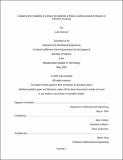| dc.contributor.advisor | Betar Gallant. | en_US |
| dc.contributor.author | Hartnett, Luke(Luke S.) | en_US |
| dc.contributor.other | Massachusetts Institute of Technology. Department of Mechanical Engineering. | en_US |
| dc.date.accessioned | 2020-10-08T21:30:41Z | |
| dc.date.available | 2020-10-08T21:30:41Z | |
| dc.date.copyright | 2020 | en_US |
| dc.date.issued | 2020 | en_US |
| dc.identifier.uri | https://hdl.handle.net/1721.1/127925 | |
| dc.description | Thesis: S.B., Massachusetts Institute of Technology, Department of Mechanical Engineering, May, 2020 | en_US |
| dc.description | Cataloged from the official PDF of thesis. | en_US |
| dc.description | Includes bibliographical references (page 31). | en_US |
| dc.description.abstract | The International Maritime Organization aims to reduce CO2 emissions in the shipping industry by 50% by 2050. One of the methods for meeting this goal is to electrify ships with lithium-ion batteries. A 14-ship sample was analyzed to determine the feasibility of installing lithium-ion batteries onto modern-day vessels. The two feasibility constraints that guided this discussion were mass and volume of the necessary battery system. Results show that the mass of the battery pack was well within the current mass of engine rooms, but the volume required was often too high. In order to compensate for this, an increase in the estimate of energy density improved the number of trips made possible by lithium-ion batteries. When coupled with increases in depth of discharge and the volume available for the system in the engine room, 11 out of 14 vessels could complete at least one trip with one charge of the battery. This corresponded to about 48% of the total miles travelled by all 14 ships. Hybrid vessels could be deployed to test out the technology, but eventually moving to lithium-ion battery technology could come close to reducing emissions by 50% under the right parameters. | en_US |
| dc.description.statementofresponsibility | by Luke Hartnett. | en_US |
| dc.format.extent | 31 pages | en_US |
| dc.language.iso | eng | en_US |
| dc.publisher | Massachusetts Institute of Technology | en_US |
| dc.rights | MIT theses may be protected by copyright. Please reuse MIT thesis content according to the MIT Libraries Permissions Policy, which is available through the URL provided. | en_US |
| dc.rights.uri | http://dspace.mit.edu/handle/1721.1/7582 | en_US |
| dc.subject | Mechanical Engineering. | en_US |
| dc.title | Analyzing the feasibility of lithium-ion batteries to reduce carbon dioxide emissions in Maritime shipping | en_US |
| dc.type | Thesis | en_US |
| dc.description.degree | S.B. | en_US |
| dc.contributor.department | Massachusetts Institute of Technology. Department of Mechanical Engineering | en_US |
| dc.identifier.oclc | 1197974322 | en_US |
| dc.description.collection | S.B. Massachusetts Institute of Technology, Department of Mechanical Engineering | en_US |
| dspace.imported | 2020-10-08T21:30:40Z | en_US |
| mit.thesis.degree | Bachelor | en_US |
| mit.thesis.department | MechE | en_US |
